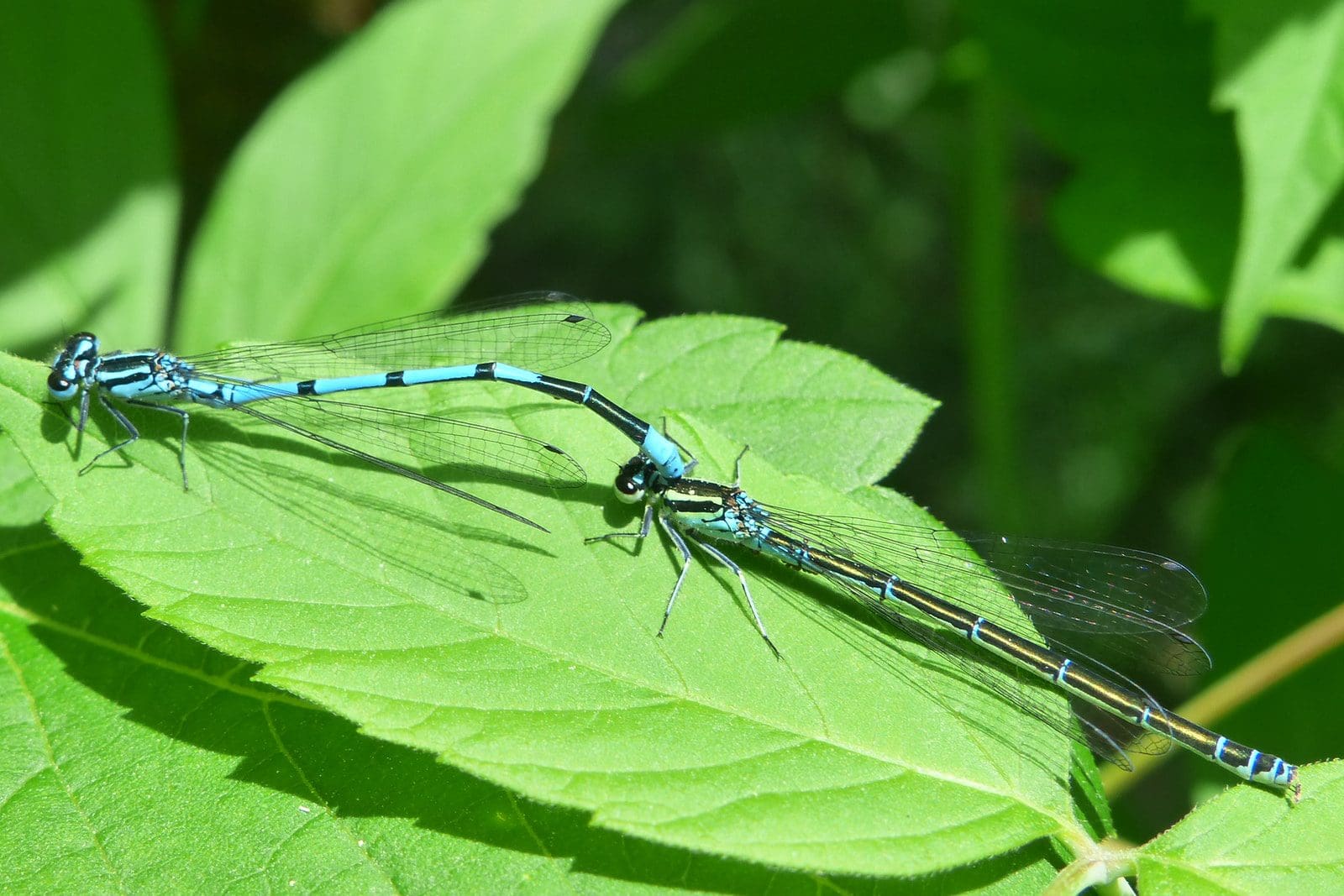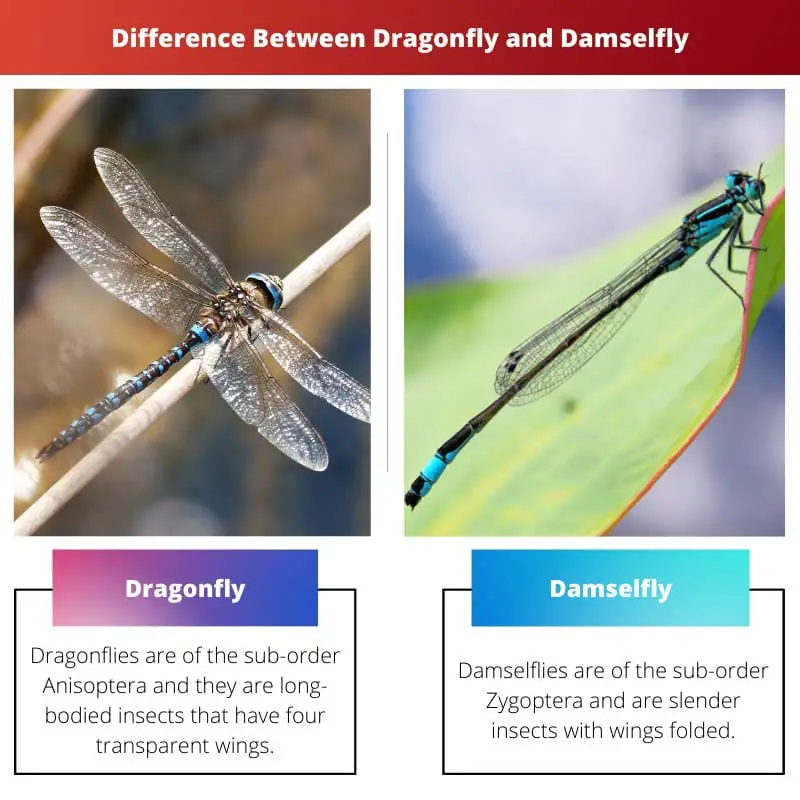Dragonflies typically have larger, sturdier bodies with their wings held out perpendicular to their bodies at rest, while damselflies have slender bodies and hold their wings parallel to their bodies when at rest. Additionally, dragonflies are usually more aggressive predators, capturing prey on the wing, whereas damselflies tend to be more delicate and often hunt by perching on vegetation near water bodies and ambushing prey.
Key Takeaways
- Dragonflies and damselflies are insects belonging to Odonata; dragonflies are part of the suborder Anisoptera, while damselflies belong to the suborder Zygoptera.
- Dragonflies have larger, sturdier bodies and hold their wings perpendicular to their bodies at rest; damselflies have slender bodies and hold their wings parallel to their bodies at rest.
- Both dragonflies and damselflies are predators, feeding on insects like mosquitoes, and are indicators of a healthy ecosystem due to their sensitivity to water quality.
Dragonfly vs Damselfly
The difference between dragonflies and damselfly is that Dragonflies have a broad and stubby bodies, eyes connect each other at a certain point, the front set of wings are comparatively more significant than the hinder set of wings, and while resting, the wings are held in an upright position. In contrast, Damselflies have slender and lengthened bodies, the eyes do not connect at a certain point, both sets of wings are collectively identical in structure and width, and while resting, the wings are nuzzled at the side of their body.

Dragonflies and damselflies are pretty similar and could perhaps appear as twins, for they are both unmistakably quick, tend to eat insects, are easy to spot, breed in freshwater (may even include waterfalls or standing water), are expert hunters, have surprisingly mesmerizing characteristics, great flying and aerobatic ability, deepwater larvae, and a captivating life process.
They are helpful to people as well. Adult Odonatas possess exceedingly strong jaws, forelimbs, and two sets of wings to capture many harmful insects like mosquitoes and other flies that cause dangerous insect-borne diseases.
Even so, detailed observation establishes precise indications/hints that even amateurs can use to highlight the differences between a dragonfly and a damselfly.
Comparison Table
| Feature | Dragonfly | Damselfly |
|---|---|---|
| Eyes | Large, compound eyes that wrap around the head | Large, compound eyes with a space between them |
| Body | Thicker, sturdier, and wider | Thin, delicate, and elongated |
| Wings | Held flat while resting, broader bases on hind wings | Held together above the body while resting, wings of similar size and shape |
| Flight | Strong, fast, and agile | Weaker, fluttering, and less agile |
| Resting position | Often lands with wings spread wide | Often lands with wings held together above the body or folded down |
| Size | Generally larger, with wingspans ranging from 1 to 5 inches (2.5 to 12.7 cm) | Generally smaller, with wingspans ranging from 0.75 to 3 inches (1.9 to 7.6 cm) |
| Habitat | Still or slow-moving freshwater environments | Similar to dragonflies, but may also be found in damp meadows and forest |
What is Dragonfly?
Anatomy and Physical Characteristics
Dragonflies possess a unique anatomy tailored for their aerial hunting lifestyle. Their elongated bodies are divided into three distinct segments: the head, thorax, and abdomen. The most distinctive feature of a dragonfly is its large, multifaceted compound eyes, which provide exceptional vision for hunting prey and navigating through the air.
Another prominent feature is their four membranous wings, each attached to the thorax. These wings are incredibly efficient, allowing dragonflies to perform intricate aerial maneuvers with astonishing speed and precision. Unlike most insects, dragonflies can move each of their four wings independently, granting them exceptional agility during flight.
Furthermore, dragonflies exhibit a diverse array of colors and patterns, ranging from iridescent blues and greens to fiery reds and oranges. These vibrant hues serve both decorative and functional purposes, aiding in camouflage, mate recognition, and warning potential predators of their toxicity.
Life Cycle and Behavior
The life cycle of a dragonfly consists of three main stages: egg, nymph, and adult. Female dragonflies typically deposit their eggs in or near water bodies, such as ponds, lakes, or streams, where the larvae, known as nymphs, will develop. Nymphs are voracious predators, feeding on a variety of aquatic organisms, including small fish, tadpoles, and insect larvae, using their extendable jaws to capture prey.
After several molts, the nymph undergoes metamorphosis, emerging from the water as a fully formed adult dragonfly. The adult stage is characterized by aerial hunting, mating, and reproductive activities. Dragonflies are highly efficient predators, using their exceptional flying skills to capture prey on the wing, including mosquitoes, flies, and other flying insects.
During mating, male dragonflies perform elaborate courtship displays to attract females, often engaging in aerial acrobatics and territorial behaviors. Once mating is successful, females lay eggs, completing the life cycle and perpetuating the next generation of dragonflies.

What is Damselfly?
Anatomy and Physical Characteristics
Damselflies share many anatomical features with dragonflies but are typically more slender and delicate in appearance. Like dragonflies, they have three distinct body segments: the head, thorax, and abdomen. Their compound eyes are large and well-developed, providing excellent vision for hunting prey and detecting potential threats.
One of the key differences between damselflies and dragonflies lies in their wing position at rest. Damselflies typically hold their wings parallel to their bodies when at rest, whereas dragonflies extend their wings perpendicular to their bodies. Additionally, damselflies tend to have smaller and more slender bodies compared to their dragonfly counterparts.
Damselflies also display a wide range of colors and patterns, often featuring hues of blue, green, and black. These colors serve various purposes, including mate recognition, camouflage, and warning signals to predators.
Life Cycle and Behavior
The life cycle of a damselfly follows a pattern similar to that of dragonflies, consisting of three main stages: egg, nymph, and adult. Female damselflies lay their eggs in or near water bodies, where the nymphs will develop. Damselfly nymphs are aquatic predators, feeding on small aquatic organisms such as mosquito larvae, small fish, and other invertebrates.
As nymphs grow and undergo several molts, they eventually emerge from the water as fully formed adult damselflies. The adult stage is characterized by aerial hunting, mating, and reproductive behaviors. Damselflies are adept flyers, using their slender bodies and delicate wings to capture prey on the wing with precision and agility.
During mating, male damselflies engage in elaborate courtship displays to attract females, often performing intricate aerial maneuvers and territorial behaviors. Once mating is successful, females lay eggs, completing the life cycle and ensuring the continuation of the species.

Main Differences Between Dragonfly and Damselfly
- Here are the main differences between dragonflies and damselflies in a bullet point list:
- Body Shape:
- Dragonflies have sturdier bodies with a broader appearance.
- Damselflies typically have slender bodies and a more delicate appearance.
- Wing Position at Rest:
- Dragonflies hold their wings perpendicular to their bodies when at rest.
- Damselflies hold their wings parallel to their bodies when at rest.
- Flight Style:
- Dragonflies are strong, agile fliers known for their fast and direct flight.
- Damselflies have a more fluttery flight style and are generally less robust fliers.
- Eyes:
- Both have large compound eyes, but damselflies’ eyes are usually more widely spaced.
- Predatory Behavior:
- Dragonflies are more aggressive predators, capturing prey on the wing.
- Damselflies often hunt by perching on vegetation near water bodies and ambushing prey.
- Abdominal Shape:
- Dragonflies’ abdomens tend to be thicker and bulkier.
- Damselflies’ abdomens are usually slender and more elongated.
- Coloration:
- Dragonflies often have bold, vibrant colors and patterns.
- Damselflies’ coloration tends to be more subdued and less striking.
- Overall Size:
- Dragonflies are generally larger than damselflies, though there can be exceptions depending on the species.

- https://bioone.org/journals/northeastern-naturalist/volume-21/issue-4/045.021.0414/Dragonfly-and-Damselfly-Colonization-and-Recolonization-of-a-Large-Semi/10.1656/045.021.0414.short
- https://journals.flvc.org/flaent/article/download/79325/76669

I found the information on dragonfly fossils and their evolution to be particularly intriguing. The history of these insects is truly fascinating.
I agree, Harrison Max. The evolutionary aspect adds a whole new dimension to our understanding of dragonflies.
The focus on the ecological significance of dragonflies and damselflies in this article was refreshing. It’s important to recognize the contribution of these insects to the environment.
Absolutely, Grant Kennedy. I’m glad this article shed light on the ecological importance of these insects.
I didn’t realize there were so many species of Odonata, and the distinctions between dragonflies and damselflies are quite fascinating. This article was very informative.
I agree, Martin84. There’s a lot to learn about these intriguing insects.
I have a newfound appreciation for dragonflies and damselflies after reading this. Their unique characteristics and important role in the ecosystem make them even more intriguing.
Same here, Dwhite. It’s fascinating to learn about these beautiful insects.
I’m enlightened. I never knew there was so much to learn about dragonflies and damselflies. Kudos to the author for providing such comprehensive information in one article.
Dragonflies and damselflies are fascinating, predacious insects that play a crucial role in maintaining a healthy ecosystem due to their sensitivity to water quality. It’s truly remarkable how these insects have evolved over millions of years.
Absolutely, Mandy78. It’s amazing to think about the history and importance of these insects.
The details about the dragonfly and damselfly larvae, flight patterns, and physical characteristics in this article were quite compelling. These insects truly are remarkable creatures!
Indeed, Ruby76. It’s amazing how much these insects contribute to the ecosystem.
The detailed comparison table and the information about dragonfly and damselfly characteristics were very well-presented. I thoroughly enjoyed reading this article.
I share your sentiments, Aaron85. The wealth of information here is truly commendable.
I agree with both of you. This article really captures the essence of these remarkable insects.
This post was both informative and engaging. Learning about the differences between dragonflies and damselflies was both educational and enjoyable.
I couldn’t agree more, Yvette White. The author did a great job of presenting the information in an engaging way.
Absolutely, Yvette White. This article really made me appreciate the complexity of these insects.
The comparison table provided is excellent and really helps to understand the differences between dragonflies and damselflies. I appreciate the detailed information in this post.
I couldn’t agree more, Helen Harris. The table is very helpful and well-organized.